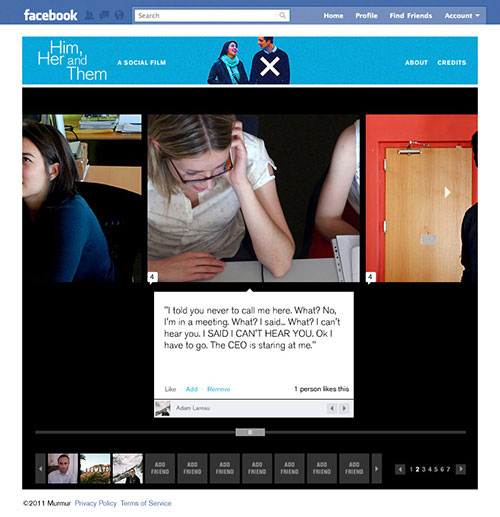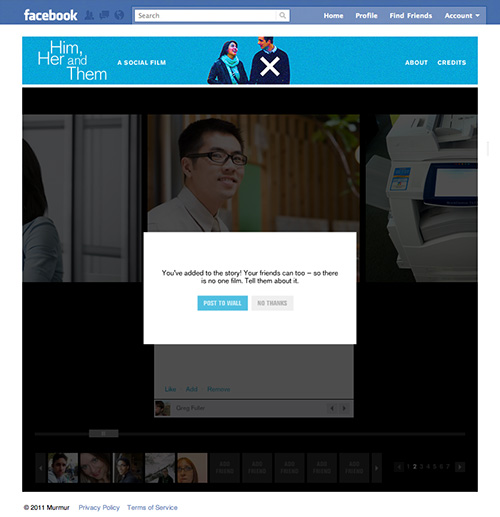It is only through our communal efforts, and subsequent sharing of our processes, successes, and failures, that we will find a way for our creative work to find & build audiences, transform them into communities, and as a result build a new creative middle class that will able to support themselves through their creations, be they of widest, most diverse and ambitious forms, styles, and content. That’s the desire right?
I was thrilled to come across Hal Siegel’s “social film” HIM, HER, AND THEM. I immediately wrote to him and asked if he would share it’s inspiration with all of you. He agreed to guest post today. Here’s hoping that this is just one of many posts to come from Hal.
The idea of something “going viral” has shifted in our collective conscious from the realm of biology to that of marketing. But unless the subject concerns puppies and kittens, the idea of content specifically designed with virality in mind seems to conjur spooky, Orwellian images of mind control and manipulation. I think it is time to move beyond these preconceptions. Let’s not forget that, from the right perspective, people too can be seen as a viral system: not a plague, but life. And for that matter, so can a film.

First, for the purpose of context, a brief personal history: I ran a small interactive agency for about ten years. For a while it was interesting and profitable, and then for a time it wasn’t interesting but was still profitable, and then finally it wasn’t interesting or profitable. To borrow from the Chinese: double unhappiness.
During that last phase, mostly out of frustration, my business partner and I talked our way into doing some unremarkable commercial video work. And here’s the thing: literally, within five minutes of the first day on set, I was hooked. I loved it. Everything about it. (Full disclosure: getting up the nerve to do this was made a lot easier by the fact that a very good friend of ours was a successful and well-regarded Director of Photography). And so I thought to myself: Fuck. I chose the wrong career. I’m a thirty-eight year old creative director with a wife and daughter and there is no way I can start over again as a film director.
Or could I? Right around the same time, innovative interactive video projects like The Wilderness Downtown and Collapsus were starting to appear. Experimental directors like Radical Friend were doing really interesting, clever things. I looked at projects like these and thought: that is exactly the kind of stuff I wish we were doing. So we started working and brainstorming. We began by thinking about interactivity and Transmedia. But the real “aha” moment came for us when we started to talk about distribution. At some point one of us said something like: well, we could always release it on Facebook. And then we thought: well, what if we integrate it into Facebook?
That was about a year ago. Him, Her and Them was released as a Facebook app in April. We refer to it as a “social film”, in that it is a combination of a traditional cinematic narrative blended with social media functionality. You can add friends (from your social network) and you and your friends can add to the story via simple text additions–much like the way that comments work. Him, Her and Them has a beginning, a middle and end, but viewers are able to make subtle changes to it along the way. You can watch the film here.
Then there’s the sharing. With a traditional video, you have one opportunity to share it—when you’re done. You watch it and, if you like it, you post it to Facebook or Twitter or your blog. Done. But now, with HH&T, every time you add to it is a point for sharing. With this, we’ve increased the potential virality exponentially. And this is just one type of interaction.

Since the release, we’ve come to think of HH&T as a “proto-social film” because it really just scratches the surface of what’s possible. Our thinking has naturally evolved since we began, and it’s fair to say that the next projects we have planned will bare little to no resemblance to Him, Her and Them. So what’s next for Murmur and social films? Naturally we are taking a hard look at social/casual games (Cityville, Farmville, etc) but also user-generated content sites and apps like Threadless and Polyvore. There is a lot here to consider. A few key insights:
Finally, For those of you readers who are sitting there shaking your head in consternation, I will say this: you are right to think that virality or social loops will not improve the quality of your film. Only a better story will do that. But what virality can do is significantly increase the size of your audience and, potentially, the money you earn. I believe that there is tremendous potential for social films, but that’s where we’re at. Potential. Will it be realized? Stay tuned.
Oh, and beware: like the transmedia movement, a social film is a complicated affair. It involves nothing less than all the traditional elements of filmmaking plus the production aspects of software development: user interface design, usability testing, programming, quality-assurance and more. Hey, I never promised you a rose garden.
— Hal Siegel
Hal Siegel is a partner in Murmur, a hybrid studio/technology company that creates and distributes social films. He wrote and directed Him, Her and Them.





